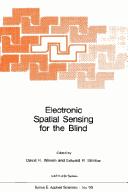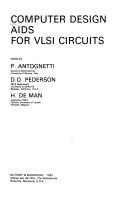| Listing 1 - 7 of 7 |
Sort by
|
Dissertation
Year: 1905 Publisher: Paris : J.-B. Baillière et fils,
Abstract | Keywords | Export | Availability | Bookmark
 Loading...
Loading...Choose an application
- Reference Manager
- EndNote
- RefWorks (Direct export to RefWorks)
Periodical
Year: 2006 Publisher: Oak Ridge, TN : U.S. Department of Energy, Office of Science,
Abstract | Keywords | Export | Availability | Bookmark
 Loading...
Loading...Choose an application
- Reference Manager
- EndNote
- RefWorks (Direct export to RefWorks)

ISBN: 9024732387 Year: 1985 Publisher: Dordrecht : Nijhoff,
Abstract | Keywords | Export | Availability | Bookmark
 Loading...
Loading...Choose an application
- Reference Manager
- EndNote
- RefWorks (Direct export to RefWorks)
Blind --- Blind, Apparatus for the --- Electronic systems --- Eyes, Artificial --- Spatial systems --- Orientation and mobility --- Congresses.
Book
ISBN: 1280972149 9786610972142 1597454494 Year: 2007 Publisher: Totowa, N.J. : Folkestone : Humana ; Shelwing [distributor],
Abstract | Keywords | Export | Availability | Bookmark
 Loading...
Loading...Choose an application
- Reference Manager
- EndNote
- RefWorks (Direct export to RefWorks)
The history of medicine has been substantially defined by a small number of monumental discoveries. Most of these breakthroughs have emerged from the biological sciences. One of the first great breakthroughs was the recognition by Koch in 1884 that pathogens could be transmitted from one living organism to another to cause disease. This profound concept led to a revolution in the approach to patient care that ultimately led to introduction of “sterile” techniques that greatly improved survivals of patients. This knowledge promoted the discovery of antibiotics 40 years later, which dramatically increased life expectancy throughout the more developed parts of the world. Another great milestone that has influenced medical care was the use of anesthesia for surgery, which was first introduced in 1846. Collectively, these three discoveries armed physicians with the knowledge and means to substantially reduce the prevalence of infectious disease, which was and still remains the leading cause of death throughout the world, and to perform a much wider range of surgeries with greatly improved survivals. The improved li- expectancies enabled the medical community to focus on a wider range of medical problems and solutions to disease.
Artificial vision. --- Eyes, Artificial. --- Artificial eyes --- Prosthesis --- Visual prosthesis --- Blindness --- Vision --- Ophthalmology. --- Neurosciences. --- Neural sciences --- Neurological sciences --- Neuroscience --- Medical sciences --- Nervous system --- Medicine --- Eye --- Diseases
Book
ISBN: 9783031066207 Year: 2022 Publisher: Cham Springer International Publishing :Imprint: Springer
Abstract | Keywords | Export | Availability | Bookmark
 Loading...
Loading...Choose an application
- Reference Manager
- EndNote
- RefWorks (Direct export to RefWorks)
For the millions of people with untreatable blindness the thought of a visual prosthesis that would allow them to live a normal life has always been a distant hope. There have been intermittent bright spots that periodically fan that hope such as when Dr. Dobelle’s visual prosthesis patient drove a car in an empty parking lot. This book will serve as an update of the work in developing a visual prosthesis. Chapters discuss the physiologic and engineering issues, alternative strategies, and patents, as well as recent research studies. Visual Prosthesis - A Concise Guide is a must-have resource for ophthalmologists, neurologists, engineers and physicists.
Artificial vision. --- Eyes, Artificial. --- Prosthesis. --- Prostheses --- Prosthetics --- Moulage in medicine --- Surgery, Plastic --- Artificial organs --- Biomedical materials --- Implants, Artificial --- Artificial eyes --- Prosthesis --- Visual prosthesis --- Blindness --- Vision --- Ophthalmology. --- Medicine --- Eye --- Diseases
Book
ISBN: 9783319190570 3319190563 9783319190563 3319190571 Year: 2015 Publisher: Cham : Springer International Publishing : Imprint: Springer,
Abstract | Keywords | Export | Availability | Bookmark
 Loading...
Loading...Choose an application
- Reference Manager
- EndNote
- RefWorks (Direct export to RefWorks)
This is the first textbook to offer a comprehensive account of ocular prosthetics and the evidence used to underpin and support this field of healthcare. It does so by bringing together information from ophthalmology, prosthetic eye and contact lens literature, and from experts actively engaged in these fields. The book describes the psychological, anatomical and physiological aspects of eye loss as well as surgical procedures for removing the eye, patient evaluation, constructing prosthetic eyes (including prosthetic and surgical techniques for dealing with socket complications), the socket’s response to prosthetic eyes, prosthetic eye maintenance and the history of prosthetic eyes. Though primarily intended for prosthetists, ophthalmologists, ophthalmic nurses, optometrists and students in the fields of ocular medicine, maxillofacial medicine and anaplastology, the book also offers a useful resource for other health workers and family members who care for prosthetic eye patients, and for those patients seeking a deeper understanding of the issues affecting them than they can find elsewhere.
Medicine & Public Health. --- Ophthalmology. --- Oral and Maxillofacial Surgery. --- Medicine. --- Surgery. --- Médecine --- Ophtalmologie --- Chirurgie --- Eyes, Artificial. --- Medicine --- Health & Biological Sciences --- Ophthalmology & Optometry --- Artificial eyes --- Oral surgery. --- Maxillofacial surgery. --- Prosthesis --- Eye --- Surgery, Primitive --- Diseases --- Dental surgery --- Oral surgery --- Surgery, Dental --- Surgery, Oral --- Oral surgeons --- Mouth

ISBN: 9028627014 9024726891 9024735696 902473259X 9048183049 9401719152 9024729386 9401095507 9401180083 9401180067 9401087911 9400951779 902472936X 9024729378 9024731186 9789024735693 9789028627017 9789024726899 Year: 1984 Volume: 134 Publisher: The Hague ; Boston : M. Nijhoff,
Abstract | Keywords | Export | Availability | Bookmark
 Loading...
Loading...Choose an application
- Reference Manager
- EndNote
- RefWorks (Direct export to RefWorks)
681.3*J2 --- 681.3*J6 --- 681.3.04 --- 681.3*J6 Computer-aided engineering: computer-aided design; CAD; computer-aided manufacturing; CAM --- Computer-aided engineering: computer-aided design; CAD; computer-aided manufacturing; CAM --- 681.3*J2 Physical sciences and engineering (Computer applications) --- Physical sciences and engineering (Computer applications) --- Computerwetenschap--?.04 --- CAD CAM --- computer-aided design --- informatica --- Computer. Automation --- CAD (computer aided design) --- Integrated circuits --- Electronic circuit design --- Computer-aided design --- Very large scale integration --- Congresses --- Design and construction --- Laser beams --- Semiconductors --- Surface chemistry --- Surfaces (Physics) --- Faisceaux laser --- Semiconducteurs --- Chimie des surfaces --- Surfaces --- Effect of radiation on --- Congrès --- Catalysis --- Catalyse --- Beam optics --- Eyes [Artificial ] --- Congresses. --- Fiber optics --- Integrated optics --- Analyse numérique --- Oxidation. --- Analyse numérique --- Heterostructures --- Molecular beam epitaxy --- Crystals --- Superlattices as materials --- Semiconductors - Surfaces - Congresses --- Surfaces (Physics) - Effect of radiation on - Congresses --- Laser beams - Congresses --- Surface chemistry - Congresses --- Integrated circuits - Very large scale integration - Congresses --- Integrated circuits - Very large scale integration - Design and construction - Congresses --- Electronic circuit design - Congresses --- Numerical analysis. --- Circuits intégrés. --- Very large scale integration. --- computer-aided design [process] --- Bond formation
| Listing 1 - 7 of 7 |
Sort by
|

 Search
Search Feedback
Feedback About UniCat
About UniCat  Help
Help News
News